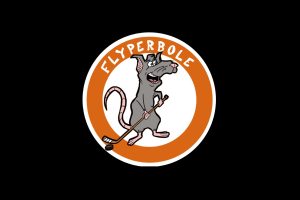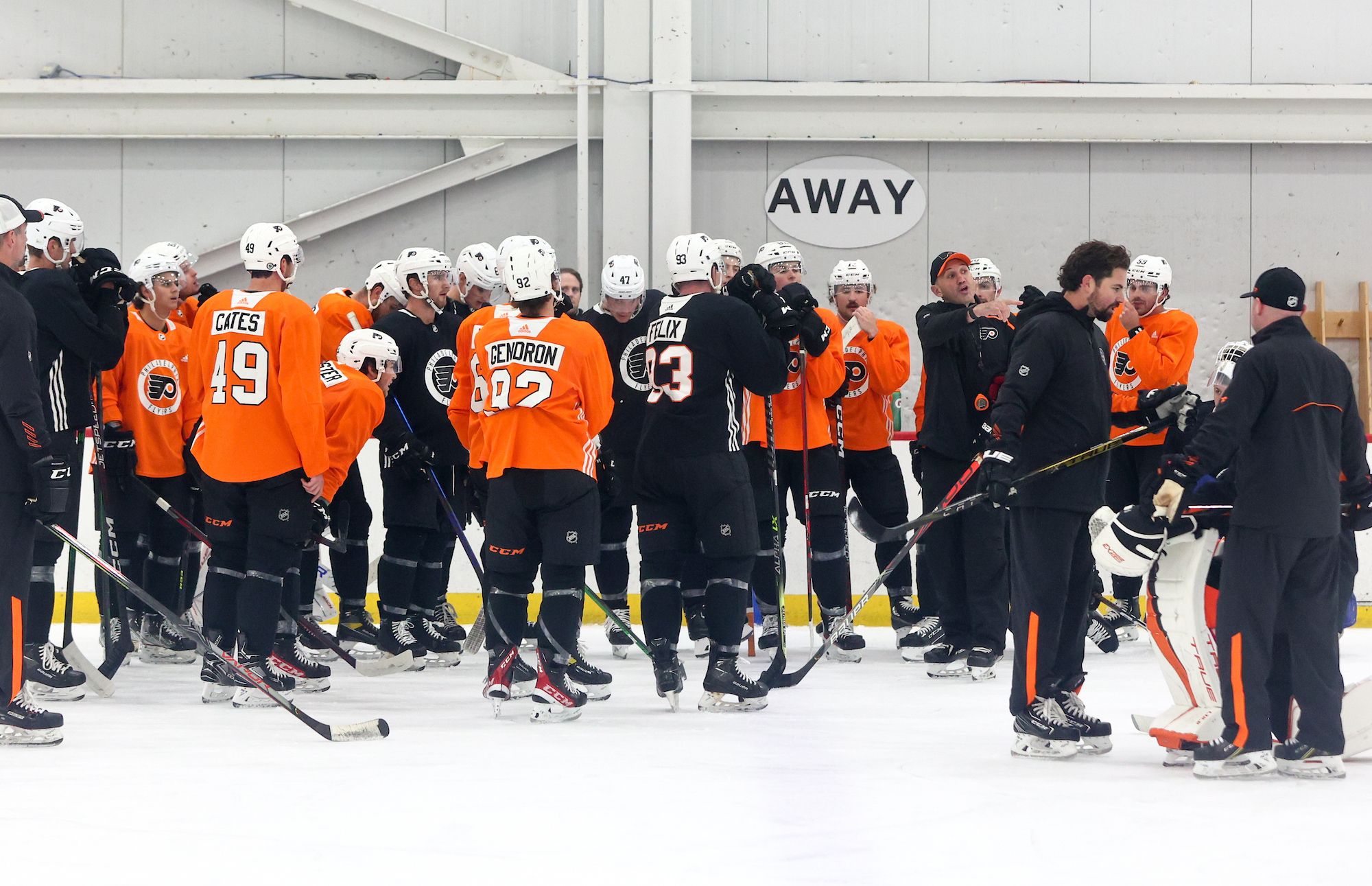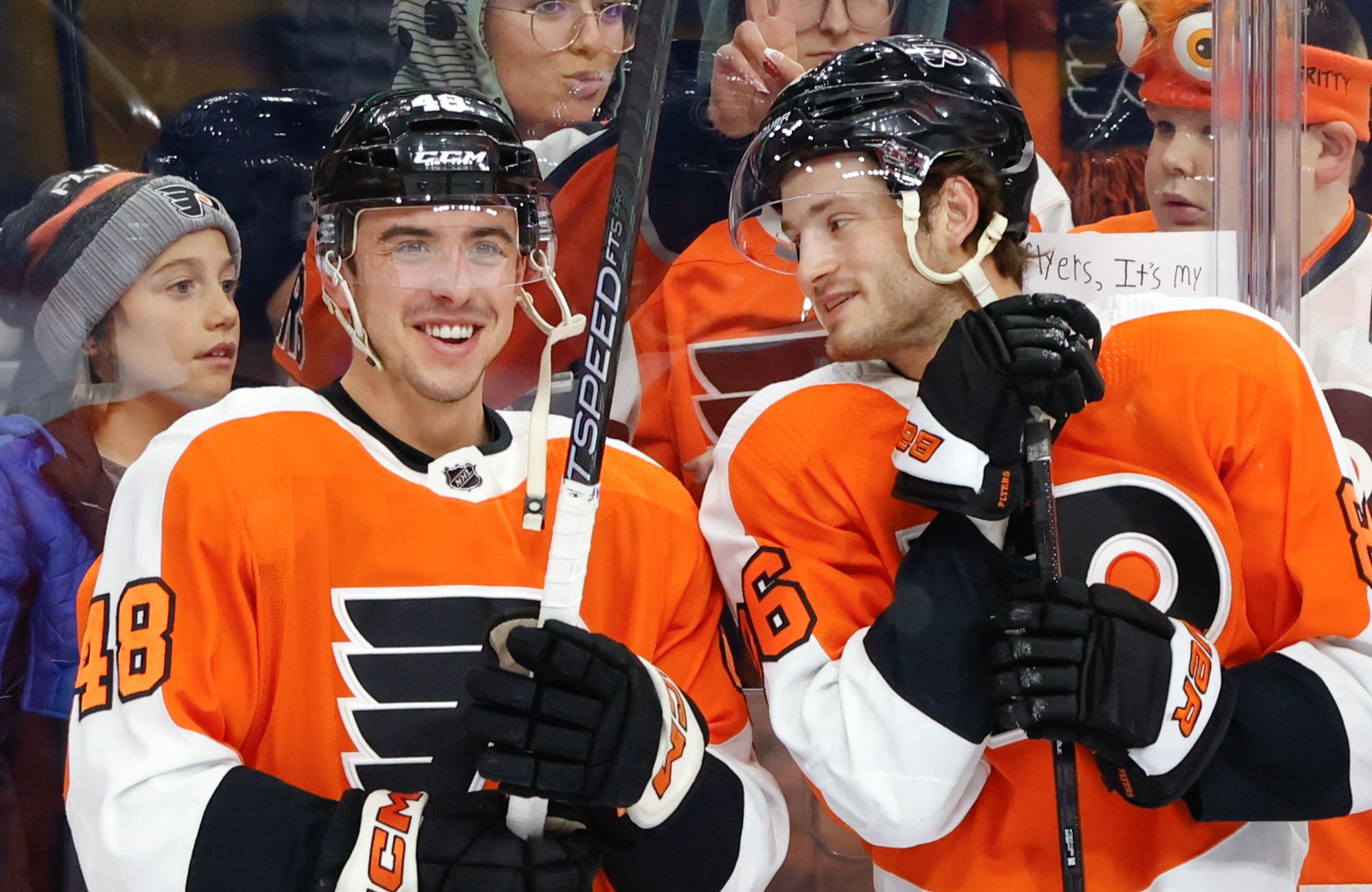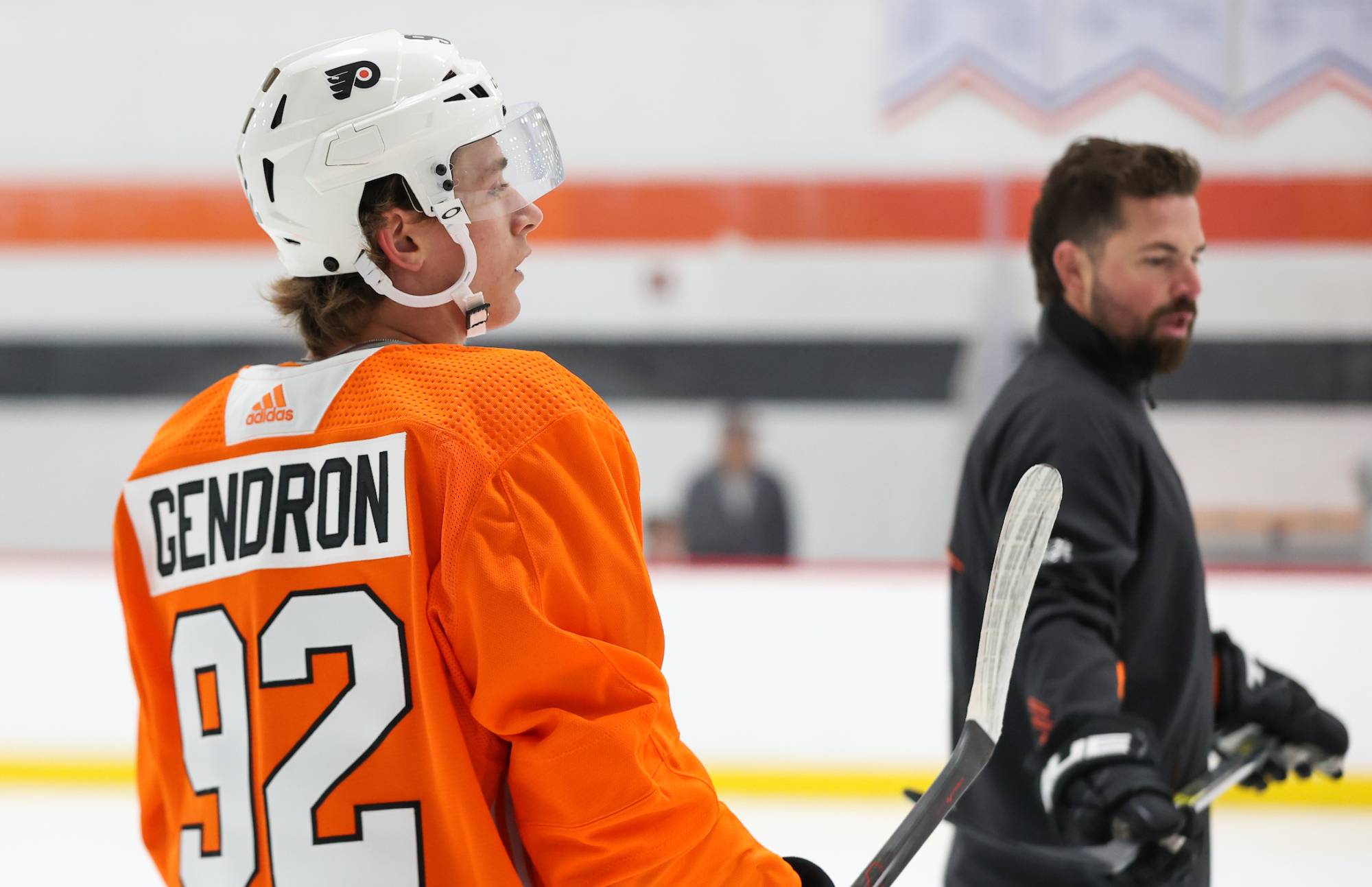Morning Observations is a feature where we break down the previous night’s game with an analytical eye.
#1: Third period went from great to awful quickly
A recurring issue for the Flyers under Dave Hakstol has been play with the lead in the third period. Last season, it was a certainty — the team would invariably halt their aggressive offensive zone forechecking, play “keep them to the outside” in the defensive zone, and get buried under a deluge of shots. In 2016-17, Philadelphia has made something of a shift, in that they appear to be making a conscious effort to keep attacking in the offensive zone, relying more on tight gaps in the neutral zone to smother opponents. It’s not a perfect strategy, since the Flyers’ defense still isn’t anything special. But it’s better than their past strategies.
Last night, the third period started out exactly how Dave Hakstol would have wanted it to go. Nursing a 1-0 lead, the Flyers ramped up the pressure, racking up a 10-3 shot attempts edge over the first nine minutes of the period, and in turn, limiting the ability of Nashville to create anything offensively. But the tide began to shift midway through the period with a few strong Predators shifts, and that’s all it really took to destroy the Flyers’ lead. Filip Forsberg redirected a Matt Irwin shot from the point to tie the score, and after that, it was all Predators. Often, a team trying to protect a lead will try to push back once an opponent ties the game, but in this case, the Flyers actually played worse with the game tied. I can’t imagine they were “sitting on” a 1-1 score, just trying to push it to overtime. It seemed more a case of poor execution by the Flyers, and especially strong play from Nashville. The result was a 10-1 shot attempt advantage for the Preds following the goal, and no realistic chance for Philadelphia to regain control in regulation.
#2: Rinne was fantastic
Despite the poor closing kick to the game, the Flyers hung right with Nashville in all of the key advanced metrics. They finished down a bit in score-adjusted Corsi at 5v5 (47.49%), but ahead in Fenwick (52.29%) and also in all-situations Expected Goals (57.37%). It wasn’t anywhere near domination, but the Flyers’ overall play certainly put them in position to come away with a victory last night.
But Pekka Rinne had no intentions of giving Philadelphia an easy two points. After six straight starts with a save percentage below 0.900, Rinne was at his best from the jump in this one. He robbed Travis Konecny twice (once in the first period, once in the third) on the doorstep, and helped keep the Flyers off the board during a second period five-on-three opportunity. The Flyers didn’t generate a ton of high-danger chances (just five on the night per Natural Stat Trick) but there were enough quality ones to score more than one goal on the night. Instead, they ran into a hot goalie, which was a major contributing factor in the loss.
NHL.com Report & Highlights | Corsica.Hockey Game Recap Page | HockeyStats.ca Recap | NaturalStatTrick Recap | HockeyViz.com | BSH Recap | Meltzer’s Musings
#3: Neutral zone passing stellar in first
After a slow start, the Flyers absolutely took Nashville to the cleaners in the first period, with only the stellar play of Rinne stopping Philadelphia from going up two or three goals after the opening stanza. They peppered the Predators goalie with 16 shots on goal and 24 total attempts, racking up half of them in a six-minute surge at the end of the period.
They succeeded by cutting Nashville’s high-pressure neutral zone defense to shreds. From the top of the faceoff circles in the defensive zone to the Predators’ blueline, the Flyers were doing everything right in terms of moving the puck up ice. Exit passes were clean, neutral zone routes were well-chosen, and players without the puck always seemed to be finding the soft spots in the Predators’ forecheck. For a team that can sometimes play an ultra-conservative, north/south game with the puck in the middle of the ice, it was refreshing to see them show off their play-driving creativity last night.
#4: Giroux line now getting bulk of tough matchups
In the heart of the Flyers’ ten-game winning streak, Dave Hakstol chose to utilize the line centered by Pierre-Edouard Bellemare as his preferred “shutdown” unit, matching them against the opponent’s best players. Supported by the pairing of Ivan Provorov and Andrew MacDonald, the Bellemare line went head-to-head with Aleksander Barkov, Connor McDavid and Tyler Seguin, to mixed results. They were largely able to keep their opponents off the scoresheet, but were often buried in terms of shot attempt differential. Last week, however, the Claude Giroux line began to see more of the toughest minutes. It was tough to say if the shift was truly intentional on the part of the Flyers’ coach, or simply due to the fact that the road team has less flexibility in picking and choosing their matchups. Last night would be the real test, as it was their first appearance at home in four games.
Yet again, Giroux’s line got the bulk of the matchup against Nashville’s top unit, centered by Ryan Johansen. The Flyers’ captain spent a little under half of his minutes playing directly against Johansen, and also spent the bulk of his time with the “top” pair of Provorov and MacDonald behind him. The Bellemare line hasn’t been relegated to bottom-six minutes, however; they received about four minutes of 5v5 ice time against Johansen and also had a number of shifts versus the Filip Forsberg line. But it looks like the days of Hakstol hard-matching Bellemare against every top line may be in the rearview mirror.
#5: Gostisbehere much better on the forecheck this year
It’s easy to think of Shayne Gostisbehere as an offensive zone dynamo. After all, he has all of the tools — plus skating ability, a blistering slapshot — that would seem to match the profile of a high-end player in the attacking third of the ice. To be sure, Ghost had no trouble scoring in that zone last year, but in terms of on-ice shot creation, his performance was less impressive. In fact, his Corsi For per 60 RelTM in 2015-16 (which measures whether his teammates generate more or less shots while away from Gostisbehere) was -0.92%, meaning that Ghost was surprisingly a slight drag on his linemates last season when it came to raw shot creation.
At first, I thought this was a fluke, but the closer I looked at Gostisbehere’s offensive zone late last season, I noticed one weakness. A key responsibility of a defenseman employed by an aggressive forechecking squad is to alertly pinch down the boards to keep pucks alive and extend cycles. The Flyers are one such squad, regularly utilizing a 2-1-2 offensive zone forecheck that requires the blueliners to activate via pinches. Gostisbehere, for all of his skill, would regularly get outmuscled by opponents along the boards when he tried to push a loose puck forward. This year, however, Ghost has become far more adept at the practice. On one play in the first period, he used a quick burst of speed to beat a Nashville player to the puck, while also dancing around his check attempt. It’s a big reason why Gostisbehere held a team-leading +10.90% CF60RelTM this season prior to last night’s game, a far cry from his slightly-negative rate in his rookie year.
#6: MacDonald with good and bad moments
For a player who spent the bulk of the 2015-16 season down in the AHL, Andrew MacDonald sure has an incredible ability to make himself the center of attention when he plays with the Flyers. Early in the year, it was his especially-awful results that had fans up in arms. Then, just as Philadelphia began its winning streak, MacDonald’s play seemed to stabilize and actually become solid. However, in recent games, his results have regressed back to career norms, but he remains on the tough minutes top pair with prized rookie Ivan Provorov. As a result, the spotlight is going to be on MacDonald moving forward, so long as he remains in that role.
And to MacDonald’s credit, he started out last night’s game strong, disrupting a few plays in the neutral zone, creating space for himself at the point, and even scoring the Flyers’ only goal of the game. The auspicious start had many ready to call this one of MacDonald’s good games. However, he began to show more cracks as the game progressed, finally culminating in a slip onto the ice when retreating into the defensive zone in coverage with less than two minutes remaining. In fact, MacDonald finished the game with a team-low 37.29% score-adjusted Corsi and 18.47% xG. The 30-year old defenseman certainly had his moments, but on the whole, it was closer to his recent play rather than his performances just after Thanksgiving, goal or no.
#7: Taylor Leier very noticeable for second straight game
Rookie Taylor Leier scored his first goal on Saturday against the Dallas Stars, using an alert middle-lane-drive tactic to get to the front of the net on a rush and bury a Nick Cousins rebound. For the second straight contest, Leier was particularly impressive, even in limited minutes (just 7:42 at 5v5). His speed is obvious, in addition to a relentless approach to puck pursuit. No, he’s not quite at Roman Lyubimov levels in that area, but Leier did draw a penalty last night, and finished with a strong 61.95% score-adjusted Corsi For percentage. He’s doing his best to make a case to stick around, even though that’s an unlikely scenario once Sean Couturier and Matt Read are ready to return after Christmas.
#8: Don’t worry about Konecny’s scoring woes
It’s now been 19 games without a goal for prized rookie forward Travis Konecny. Last night, the continued drought certainly wasn’t for a lack of trying — in fact, Konecny had Philadelphia’s two most dangerous scoring chances of the night, only to be stoned by Rinne both times. And that’s why it’s hard to be too concerned about Travis Konecny right now. He has 39 shots on goal over the “slump,” which would put him on pace for about 168 over an 82-game season. So this isn’t a shot volume issue. Instead, Konecny is just snakebitten right now, and that almost certainly will not last forever.
If I was going to get concerned about anything Konecny-related at this point, it would be the amount of punishment he’s taken from opponents in recent games. Yesterday, Mattias Ekholm and Ryan Ellis both took liberties with the young forward, and they aren’t the first to do so. Konecny is an inviting target — an aggressive, puck-carrying forward who initiates contact regularly but doesn’t have ideal NHL size. In fact, that was supposedly one of the reasons that he slipped so far in the draft, aside from a just-okay draft year in juniors. Some scouts worried that Konecny could only succeed playing his current hard-nosed style, but would wear down at the NHL level as a result. So far, that hasn’t happened, but it remains a legitimate concern, especially accounting for the pounding that he’s taking from opponents.
#9: Power play just a bit off
After a stellar first period, the Flyers had multiple opportunities to put this game out of reach in the middle stanza. They drew three Nashville penalties, including two just 36 seconds apart to earn an extended 5-on-3 power play. But the stellar top unit could not break through. Jakub Voracek in particular seemed out of sorts on the PP, both in the offensive zone and on entry attempts. Still, the top unit did blast away on the whole, racking up a stellar 163.93 Corsi For per 60 at 5v4 and 227.27 on their 5v3 chance. They just lacked that one no-doubt-about-it shot that could have turned this game into a comfortable victory.
#10: Ghost-Manning the sheltered pairing and that’s not necessarily bad
It’s tough to argue that the defensive duo of Brandon Manning and Shayne Gostisbehere isn’t getting used as the third pair right now. Despite little in the way of special teams time last night, Manning and Gostisbehere ranked fifth and sixth in 5-on-5 ice time. Some of that may be a result of the current pairings — after all, Del Zotto-Gudas was Hakstol’s big minutes duo last year, and he’s clearly in love with the Provorov-MacDonald pair.
The good news is that Gostisbehere and Manning are thriving in the limited (and sheltered) minutes. Ghost was given 10 offensive zone draws and zero in the defensive zone, and also faced off against top-six centers Johansen and Ribeiro for just a combined 1:05 minutes of ice time. The result was an insane 83.09% score-adjusted Corsi for Gostisbehere, and a 76.77% mark for Manning. They may be getting easy minutes right now, but the duo is doing exactly what you want them to do in those minutes — they’re crushing them. I will say that, to my eyes, Ghost was so effective at 5v5 last night that I believe he could have taken slightly tougher minutes and still been incredibly successful. But I see the wisdom in sheltering the pair, as well.









